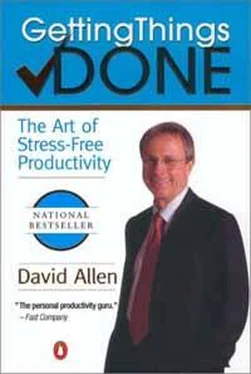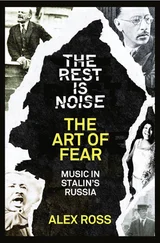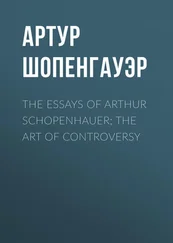When a culture adopts "What's the next action?" as a standard operating query, there's an automatic increase in energy, productivity, clarity, and focus.
One of the greatest challenges you may encounter is that once you have gotten used to "What's the next action?" for yourself and those around you, interacting with people who aren't asking it can be highly frustrating. It clarifies things so quickly that dealing with people and environments that don't use it can seem nightmarish.
We are all accountable to define what, if anything, we are committed to make happen as we engage with ourselves and others. And at some point, for any outcome that we have an internal commitment to complete, we must make the decision about the next physical action required. There's a great difference, how-ever, between making that decision when things show up and doing it when they blow up.
The Source of the Technique
I learned this simple but extraordinary next-action technique twenty years ago from a longtime friend and management-consulting mentor of mine, Dean Acheson (no relation to the former secretary of state). Dean had spent many prior years consulting with executives and researching what was required to free the psychic logjams of many of them about projects and situations they were involved in. One day he just started picking up each individual piece of paper on an executive's desk and forcing him to decide what the very next thing was that he had to do to move it forward. The results were so immediate and so profound for the executive that Dean continued for years to perfect a methodology using that same question to process the in-basket. Since then both of us have trained and coached thousands of people with this key concept, and it remains a foolproof technique. It never fails to greatly improve both the productivity and the peace of mind of the user to determine what the next physical action is that will move something forward.
Creating the Option of Doing
How could something so simple be so powerful—"What's the next action?"
To help answer that question, I invite you to revisit for a moment your mind-sweep list. Or at least to think about all the projects that are probably sitting around in your psyche. Do you have a sense that they haven't been moving along as consistently and productively as they could be? You'll probably admit that yes, indeed, a few have been a little bit "stuck."
If you haven't known for sure whether you needed to make a call, send an e-mail, look up something, or buy an item at the store as the very next thing to move on, it hasn't been getting done. What's ironic is that it would likely require only about ten seconds of thinking to figure out what the next action would be for almost everything on your list. But it's ten seconds of thinking that most people haven't done about most things on their list.
For example, a client will have something like "tires" on a list.
I then ask, "What's that about?"
He responds, "Well, I need new tires on my car."
"So what's the next action?"
At that point the client usually wrinkles up his forehead, ponders for a few moments, and expresses his conclusion: "Well, I need to call a tire store and get some prices."
That's about how much time is required to decide what the "doing" would look like on almost everything. It's just the few seconds of focused thinking that most people have not yet done about most of their stuff.
It will probably be true, too, that the person who needs tires on his car has had that on his radar for quite a while. It's also likely that he's been at a phone hundreds of times, often with enough time and/or energy only to make just such a call. Why didn't he make it? Because in that state of mind, the last thing in the world he felt like doing was considering all his projects, including getting tires, and what their next actions were. In those moments he didn't feel like thinking at all.
What he needed was to have already figured those things out. If he gets that next-action thinking done, then, when he hap-pens to have fifteen minutes before a meeting, with a phone at hand, and his energy at about 4.2 out of 10, he can look at the list of options of things to do and be delighted to see "Call tire store for prices" on it. "That's something I can do and complete successfully!" he'll think, and then hell actually be motivated to make the call, just to experience the "win" of completing something useful in the time and energy window he's in. In this context he'd be incapable of starting a large proposal draft for a client, but he has sufficient resources for punching phone numbers and getting simple information quickly. It's highly probable that at some point soon he'll look at the new set of tires on his car and feel on top of the world.
The secret of getting ahead is getting started. The secret of getting started is breaking your complex overwhelming tasks into small manageable tasks, and then starting on the first one.
—Mark Twain
Defining what real doing looks like, on the most basic level, and organizing placeholder reminders that we can trust, are master keys to productivity enhancement.
These are learnable techniques, and ones that we can continue to get better at.
Often even the simplest things are stuck because we haven't made a final decision yet about the next action. People in my seminars often have things on their lists like "Get a tune-up for the car." Is "Get a tune-up" a next action? Not unless you're walking out with wrench in hand, dressed for grease.
"So, what's the next action?"
"Uh, I need to take the car to the garage. Oh, yeah, I need to find out if the garage can take it. I guess I need to call the garage and make the appointment."
"Do you have the number?"
"Darn, no ... I don't have the number for the garage. Fred recommended that garage to me, and I don't have the number. I knew something was missing in the equation."
Without a next action, there remains a potentially infinite gap between current reality and what you need to do.
And that's often what happens with so many things for so many people. We glance at the project, and some part of us thinks, "I don't quite have all the pieces between here and there." We know something is missing, but we're not sure what it is exactly, so we quit.
"So, what's the next action?""I need to get the number. I guess I could get it from Fred.""Do you have Fred's number?""I have Fred's number!"So the next action really is "Call Fred for the number of the garage."
Did you notice how many steps had to be tracked back before we actually got to the real next action on this project? That's typical. Most people have many things just like that on their lists.
Why Bright People Procrastinate the Most
It's really the smartest people who have the highest number of undecided things in their lives and on their lists. Why is that? Think of how our bodies respond to the images we hold in our minds. It appears that the nervous system can't tell the difference between a well-imagined thought and reality. To prove this to yourself, picture yourself walking into a supermarket and going over to the brightly lit fruit-and-vegetable section. Are you there? OK, now go to the citrus bins—oranges, grapefruits, lemons. Now see the big pile of yellow lemons. There's a cutting board and a knife next to them. Take one of those big yellow lemons and cut it in half. Smell that citrus smell! It's really juicy, and there's lemon juice trickling onto the board. Now take a half lemon and cut that in half, so you have a quarter lemon wedge in your hands. OK, now—remember how you did this as a kid?— put that quarter of a lemon in your mouth and bite into it! Scrunch!
Bright people have the capability of freaking out faster and more dramatically than anyone else.
Читать дальше











